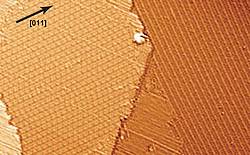 |
Ordering and Stabilization of Metal-Organic Coordination Chains by Hierarchical Assembly through Hydrogen Bonding at a Surface
Researchers from the FunSMARTs II project including groups from the Max Planck Institut für Festkörperforschung (Stuttgart, Germany), the Institute de Physiques des Nanostructures (EPFL, Lausanne, Switzerland) and the Institut für Nanotechnologie am Forschungszentrum (Karlsruhe, Germany), have shown that highly ordered self-organized supramolecular structures can be obtained by using a multi-component approach combining polyaromatic bipyridine molecules with a hydrogen-bonding species such as linear bis(carboxylic acids) on a copper (100) surface. The resulting supramolecular structures are thermally robust due to the stable hydrogen-bonding-type interaction and exhibit extended and highly ordered domains as observed by Scanning Tunneling Miscroscopy. Parameters such as chain segment length and interchain spacing can be tuned indipendently by choosing the adapted building blocks. This demonstrates the potentialities of this bottom-up technique for the fabrication of complex architectures with tailored properties.
These results have been published in Angew. Chem. Int. Ed. 2008, 47, 8835–8838.

